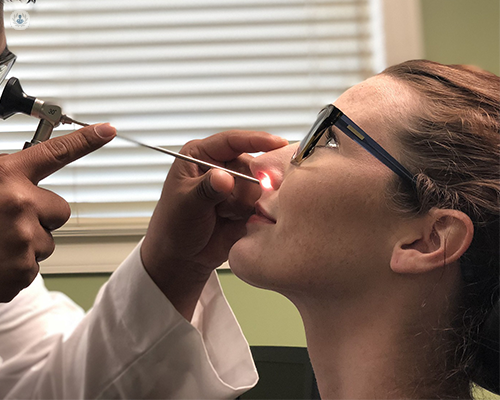Allergic nasal polyposis
Mr Guna Reddy-Kolanu - Otolaryngology / ENT
Created on: 11-13-2012
Updated on: 09-27-2023
Edited by: Kate Forristal
What is allergic nasal polyposis?
Allergic nasal polyps are semi-transparent, soft, painless growths that form in the nasal passages or sinuses. They are benign, but they can obstruct the nostrils if they grow too big. They can develop in different places within the nasal cavity and hang down like teardrops and typically occupy the roof and the sides of the nostrils.
You should see an ENT specialist for advice on treatment.

Symptoms of allergic nasal polyposis
The symptoms of nasal polyps can vary depending on their size, how many they are and where they are located in the nasal passage. Initially, you may notice a slight loss of smell and taste, which can progressively get worse and cause a partial or complete nasal obstruction. This may be accompanied by a constant feeling of mucus in your nasal passages which isn’t relieved even if after blowing your nose.
The common signs and symptoms include:
- A runny nose
- Postnasal drip
- Loss of smell and taste
- Facial pain or headache
- A sense of pressure over the forehead
- Snoring
- Nosebleeds
What are the causes of allergic nasal polyposis?
There are different reasons why polyps develop. They are often a result of chronic inflammation and associated with allergies, as well as asthma, infections and certain types of immune disorders.
Experts don’t fully understand why they appear but they believe they might develop in people who have a distinct immune response and chemical markers in their mucous membranes. Other causes could be from prolonged irritation in the nasal passages. After the nasal mucosa becomes red and swollen, it produces fluid and eventually forms a polyp.
Polyps can develop at any age, although they are more common in young and middle-aged adults.
Can they be prevented?
To prevent polyps, you should focus on treating allergies or asthma well. It is also important to avoid nasal irritations and practise good hygiene by using saline washes. You can try using humidifiers at home to help hydrate your nostrils.
If you have allergies, make sure you are taking the correct antihistamines, nasal sprays and/or allergy shots to help prevent polyps developing.
What does treatment consist of?
Medical treatment depends on the size of a polyp, but it may consist of topical corticosteroid, oral corticosteroid and/or antibiotics if there is a persistent infection.
If treatment doesn’t help, then surgical treatment may be recommended. This is called a polypectomy which consists of removing the nasal polyps and mucosa with a small suction device or microdebrider.
For particularly larger polyps, you can undergo an endoscopic sinus surgery, which incorporates the use of a thin, flexible endoscope and a tiny camera on the end of it to find the polyps and remove them. The doctor may enlarge the openings of your sinus cavities too.
The most effective form of treatment is find what is causing your allergic reactions and eliminating it from your surroundings.
